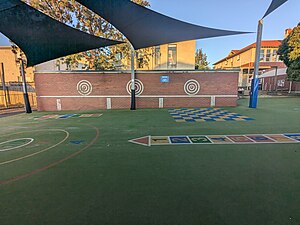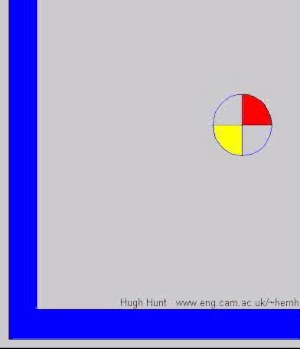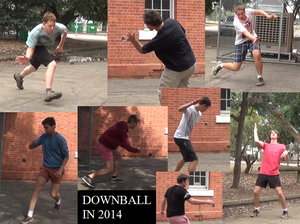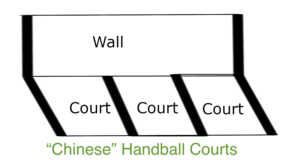Downball: Difference between revisions
Paul Martin (talk | contribs) |
Paul Martin (talk | contribs) |
||
| Line 69: | Line 69: | ||
== See also == | == See also == | ||
[[File:Downball in the Australian schoolyard.jpg|thumb|right| '''squares games''' - Downball (squares game), Four square, Handball (schoolyard game) | [[File:Downball in the Australian schoolyard.jpg|thumb|right| '''squares games''' - Downball (squares game), Four square, Handball (schoolyard game)]] | ||
'''squares games''' | '''squares games''' | ||
* Downball (squares game)<ref name="OED">{{Cite OED|Downball|7637506882}}</ref> | * Downball (squares game)<ref name="OED">{{Cite OED|Downball|7637506882}}</ref> | ||
Revision as of 18:54, 21 July 2024
Downball(wall and ball game)
Downball(wall and ball game) is a wall and ball game mostly played by children on the Australian continent[1][2][3][4]. It is also played on the North American continent where it is known as "Chinese" variation of the wall and ball game.
Downball(wall and ball game) is a game of bouncing a ball against a wall and taking it in turns to hit it back with your hand.
Downball(wall and ball game) is a popular schoolyard game played against a wall with a ball.
In reference to Australian Primary Schools: "The most popular ball game played against a wall in today’s schools – called Wall Ball, Handball or Downball"[5]
Downball(wall and ball game) is similar to other wall and ball games in that a wall is required. However one rule sets the game apart from other wall and ball games. The rule is that once the player hits the ball, the ball must bounce once then hit the wall next. Otherwise play stops and last player to hit the ball is out.
The downward path of the ball so that it bounces before hitting the wall is where the "down" part of the name Downball(wall and ball game) comes from. This feature of the game provides for some characteristics of game play including:
- the ball rebounds up of the wall and then travels in an arc backwards towards the ground and bounces
- the balls travel backwards of the wall is slowed
- more time is available to get to the ball and take a shot which allows a slower paced game and facilitates group play
Group play is the most common form of the game and the number of players is only limited by the size of the wall and the available space. The server holds serve until they default their serve or go out. Players take turns returning the ball. Players go out if their attempt to return the ball is not successful. Also if the ball bounces twice after rebounding of the wall then the player closest to the ball goes out. Play continues until all but one player is out and the last remaining player is the winner of that game.
Downball(wall and ball game) is commonly played at recess (‘recess’ is the term describing free playtime in mid-morning) and lunchtime in primary schools.
Downball(wall and ball game) is commonly played with a tennis ball or rubber ball on a wall of a school building or school playground. It is also played in community playgrounds on multipurpose walls and on practice walls at community tennis clubs.
Downball naming conventions in Australia
For many years in Australia both Downball(wall and ball game) and Downball (squares game) proponents have called each game "Downball". This naming problem is based on local folk-law or tradition.
Generally speaking having two games both called Downball does not cause a problem in play because Downball (squares game) goes by alternative names.
North American variation
This variation of Downball(wall and ball game) has the defining ball bouncing on the ground before the wall[6][7][8]. The "Chinese" variation[9] is a game version that utilises street sidewalk squares as a court against a building wall.
Timeline
Bouncing a ball against a wall game is first mentioned in 1916[10].
On July 4, 1954, the American folklorist Dorothy Howard arrived in Australia.
In her ten months in Australia in 1954–5 as a post-doctoral Fulbright scholar based at the University of Melbourne, she travelled across the land, collecting and documenting children’s games and verbal lore in cities, country towns and small rural communities. Her meticulous work laid the foundation for research into children’s folklore in this country.[11]
Published in 1975, "The great American book of sidewalk, stoop, dirt, curb, and alley games" by Fred Ferretti and Jerry Darvin[12] details "Chinese" variation of the wall and ball game that utilise street sidewalk squares as a court against a building wall as follows:
- two sidewalk squares against a building wall - played in Queens and in the West Oak Lane section of Philadelphia
- five sidewalk squares against a building wall - played in Brooklyn's Bay Ridge section
Starting in 2010, the Childhood, Tradition and Change Project research team visited nineteen primary schools across the Australian continent to take a detailed sample of playground games being played. Downball(wall and ball game) was recorded as being played at school_05[13], school_10[14] and school_14[15].
Today, Downball(wall and ball game) is part of the physical education curriculum at primary schools where children develop the skills of hitting and control of the ball by hand[16] before embarking on tennis, volleyball and badminton.
In the future Australia's population is expected to reach 30 million by 2030. With the concomitant growth of Australian suburbs including new primary school and new community playgrounds, multipurpose walls are being built allowing more people to play Downball(wall and ball game) in Australia.
Downball(wall and ball game) belongs in the ball game category but is not a squares game. Downball(wall and ball game) belongs in the wall and ball game category but is not a hand squash game.
See also
squares games
- Downball (squares game)[1]
- Four square (squares game)
- Handball (schoolyard game) (squares game)
hand squash games
- Australian Handball (hand squash game)
- Australian handball (hand squash game)
- American handball (hand squash game)
- Butts Up (hand squash game)
- One-wall handball (hand squash game)
- Wallball - list of (hand squash games)
References
- ↑ 1.0 1.1 Template:Cite OED
- ↑ Kate Johnstone, J.R.M.R. (2019) ‘Diamond Strikes the Right Note’, Geelong Advertiser, 13 July, p. 15. Available at: https://search.ebscohost.com/login.aspx?direct=true&db=bwh&AN=9X9GATNEWSMMGLSTRY000396867356&site=eds-live&scope=site (Accessed: 15 July 2024)
- ↑ Josh Barnes 2018, ‘Schools set to benefit’, Diamond Valley Leader, 14 November, p. 5, viewed 15 July 2024, <https://search.ebscohost.com/login.aspx?direct=true&db=bwh&AN=9X9DVVNEWSMMGLSTRY000377627827&site=eds-live&scope=site>.
- ↑ Maroondah Leader (2018) ‘Ballin’ for the farmers’, 9 October, p. 5. Available at: https://search.ebscohost.com/login.aspx?direct=true&db=bwh&AN=9X9MMVNEWSMMGLSTRY000376717136&site=eds-live&scope=site (Accessed: 15 July 2024).
- ↑ Mckinty, Judy. (2016). 'Losing our Marbles: what's happening to children's folklore in schools?'. Play and Folklore no 66, December 2016. Play and Folklore. 37-44.
- ↑ Hume, D. (2005) ‘Recreational Games for Physical Education’, Strategies, 18(3), pp. 27–30. doi: 10.1080/08924562.2005.10591137.
- ↑ Gutelle, A. (1989) ‘Games Kids Play Grab a Ball and Play! These “’City”’ Games Are Great Anywhere’, Sports Illustrated for Kids, p. 44. Available at: https://search.ebscohost.com/login.aspx?direct=true&db=f6h&AN=54507860&site=eds-live&scope=site (Accessed: 19 July 2024).
- ↑ Jones, R.F. (1969) Sports Illustrated, 30(21), p. 82. Available at: https://search.ebscohost.com/login.aspx?direct=true&db=f6h&AN=54029246&site=eds-live&scope=site (Accessed: 19 July 2024).
- ↑ (1975) The great American book of sidewalk, stoop, curb and alley games. New York : Workman Pub. Co., page 78-79.
- ↑ Douglas, Norman (1916). London Street Games. The St. Catherine Press, page 5.
- ↑ Factor, J., 2004. Tree stumps, manhole covers and rubbish tins: The invisible play-lines of a primary school playground. Childhood, 11(2), pp.142-154. url= https://journals.sagepub.com/doi/abs/10.1177/0907568204043049
- ↑ (1975) The great American book of sidewalk, stoop, curb and alley games. New York : Workman Pub. Co., page 78-79.
- ↑ Melbourne, The University of. Downball - Ball Game - Childhood, Tradition and Change PUBLIC DATABASE (en-gb).
- ↑ Melbourne, The University of. Downball - Ball Game - Childhood, Tradition and Change PUBLIC DATABASE (en-gb).
- ↑ Melbourne, The University of. Downball - Ball Game - Childhood, Tradition and Change PUBLIC DATABASE (en-gb).
- ↑ BOROONDARA PARK PRESS Issue 6 (en-gb) (26 Apr 2024).
Further Reading
Primary Sources



